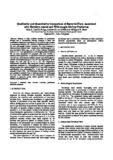Qualitative and quantitative comparison of bacterial flora associated with hatchery-reared and wild-caught shrimp postlarvae
Share
Abstract
Because of high mortality recorded in pond-reared shrimps due to luminescent vibriosis infection, a study was conducted to determine if postlarvae (PLs) could be major sources of luminescent bacteria (LB). Batches of hatchery-reared (PL12 to 18) and wild-caught Penaeus monodon PLs were examined to determine their bacterial load. Results show that although all PLs have associated Vibrio spp., not all of them harbored detectable levels of LB. Fifty eight percent of wild-caught postlarval batches did not have associated LB compared with only 23-44% of hatchery-reared postlarvae. A significant difference in quantitative LB load was noted between hatchery reared and wild-caught PLs with the former harboring up to 3.0 x 105 cfu LB/postlarva. Wildcaught PLs had only up to 3.5 x 102 cfu LB/postlarva. Antimicrobial sensitivity tests using disc diffusion method show significant resistance to Chloramphenicol and Oxytetracycline among isolates from hatchery-reared PLs (33 and 44%) compared with bacteria from wild-caught PLs (3 and 6%) and near shore seawater (0 and 12%). The differences between the quantitative and qualitative bacterial flora of hatchery-reared and wild-caught PLs may have contributed to the occurrence of luminescent vibriosis in grow-out ponds, which generally make use of hatchery-reared postlarvae.
Suggested Citation
Lavilla-Pitogo, C. R., de la Peña, L. D., & Paner, M. G. (2005). Qualitative and quantitative comparison of bacterial flora associated with hatchery-reared and wild-caught shrimp postlarvae. In Proceedings of the International Workshop: Antibiotic Resistance in Aquaculture Environments, 24-25 February 2005, Chiang Mai, Thailand (pp. 1–7). Chiang Mai, Thailand: ASIARESIST.



